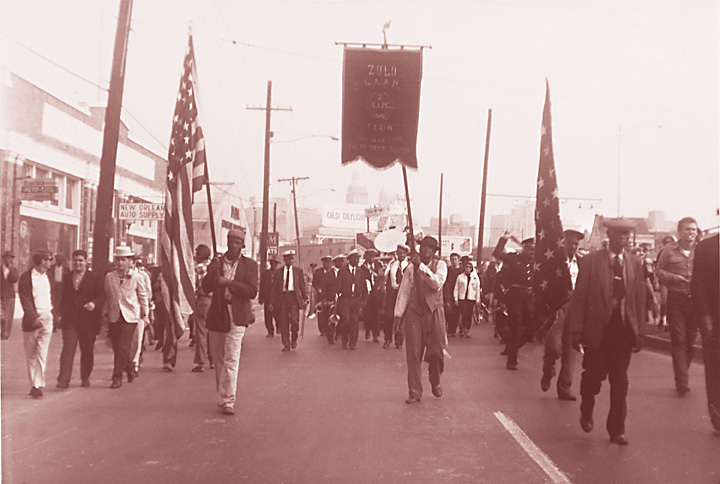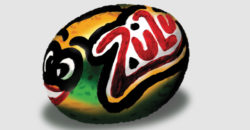Magazine
From Tramps to Kings: Celebrating One Hundred Years of Zulu 1909-2009
Published: February 1, 2016
Last Updated: February 15, 2023

Hand-painted coconuts are the prized throw distributed by members of Zulu on Mardi Gras day.

In February 1949, New Orleans’ native son and musical ambassador Louis Armstrong reigned as King Zulu. He brought international media recognition to the Zulu Club and its unique traditions. Louisiana State Museum
From Tramps to Kings
Most New Orleans residents know Zulu as a parading organization. But few realize that Zulu is a social aid and pleasure club in the mold of the countless African-American benevolent associations that have provided essential social services, such as funeral costs, for members since the 19th century. The earliest Zulu parades were sponsored by African-American businesses, the most significant of which were the Gertrude Geddes Willis Funeral Home and Good Citizens Insurance Company. The original Geddes location was in Uptown’s Third Ward, at the intersection of Jackson and Simon Bolivar avenues, a location that has for decades served as an important meeting spot for the parade. Before the 1960s, the parade began downtown (the downriver side of Canal Street) and worked its way uptown. Today, the route is almost the opposite of its historic route, as the Zulu parade begins at the uptown Geddes site and winds its way downtown.
Zulu claims that its origins date to 1909, when a group of the original founders, who were mostly working men and laborers, paraded as a social club called the Tramps. According to Zulu history, the Tramps dressed in ragged trousers and paraded on foot to the music of a jubilee singing quartet. The first king, William Story, wore a lard-can crown and carried a banana stalk as a scepter. The original Zulus took their inspiration from a vaudeville troupe known as the Smart Set, which performed a skit at the Pythian Temple Theater featuring a Zulu theme, and entitled “There Never Was and Never Will Be A King Like Me.” This intersection of popular culture and masking is not surprising given that the new Pythian Temple (234 Loyola Avenue), built and owned by the black Knights of Pythias fraternal organization, was located one block from the original Zulu clubhouse on Perdido at Loyola Avenue, where a parking lot exists today.
In 1916, the club officially incorporated and then gradually gained a legion of supporters with their Mardi Gras antics. After World War I, a visionary club member and army veteran, James Robertson, instituted the dramatic arrival of King Zulu by water vessel, a custom first pioneered by Rex, known as the king of Carnival, on the Mississippi riverfront in 1874. Whereas Rex arrived in the front of town, King Zulu now arrived among his subjects in the back of town, where the Old Basin Canal crossed Claiborne Avenue. By the 1930s, huge crowds of New Orleanians lined up at the canal to await King Zulu. This custom fell by the wayside in the 1950s when the city filled in the Old Basin Canal, but Zulu eventually reprised the waterborn landing in the early 1990s with a riverfront arrival for the annual Lundi Gras festival at Woldenberg Park.

From 1917 into the 1950s, King Zulu arrived at the Old Basin canal by boat to begin the Zulu parade. Hundreds of persons gathered at the landing site to welcome the King during these years.
The Characters and Queens
During the 1930s, many of the well-known characters from the mythical Land of Zulu evolved. Early photographs from the 1920s document the existence of Zulu policemen, who protected the King and Queen from the crowds. In the 1930s, there emerged the Witch Doctor, an obviously African-inspired character who is known as the sorcerer or prophet. Zulu’s Witch Doctor is responsible for ensuring safety and good health for the Zulu king and the members of the club. He also prays for good weather for all carnival activities. In that decade, the Big Shot character also materialized. The role of the Big Shot is to “outdo” the king. In the earlier days the term “outshine” was used, which meant to look better than someone else. In the land of Zulu, no one sees the king without seeing the Big Shot first — the man behind the throne. Over time, other characters, including the Province Prince, the Governor, the Mayor, the Ambassador, and Mr. Big Stuff, were created. William “Sunny Jim” Poole is given credit for creating the Mr. Big Stuff character in 1973. Singer Jean Knight’s 1971 hit soul song of the same name helped to institutionalize the new character quickly. Given the importance of these characters to the parade antics of Zulu, the state museum exhibit will feature a well-balanced mix of historic and contemporary character costumes.
In the 1930s, Zulu changed significantly when the club allowed women to serve as queens for the first time, and the Zulu Ladies Auxiliary was formed. Prior to 1933, Zulu was all-male affair, and beginning in 1923, male members masked as the queen on Mardi Gras. In an effort to modernize and acknowledge the important role of women in Zulu activities, the club abandoned the all-male rules. The first female queens from the 1930s dressed in beautiful gowns with long flowing mantles suitable for their respected positions. The Ladies Auxiliary continues to play an integral role in Zulu activities to this day.
Coconuts and King Louis
Zulu is well known for its coconut tradition, in which parade riders use hand-decorated coconuts as carnival throws on Mardi Gras. Zulu historians believe that the prized items date back to 1910, fitting in with the African theme and the popular viewing of Africa as a tropical land filled with coconuts. Since New Orleans was a major port for Latin American bulk goods such as coconuts, it is not surprising that the item was adopted. A major centerpiece of the Zulu Centennial exhibit will be a re-created coconut decorating workshop displaying the various steps in the decorating process. Few persons have the opportunity to witness the hand-crafting of Zulu coconuts, and this exhibit will allow visitors to view closely each step of the process as the coconuts are shaved, polished, painted and decorated.
The exhibit will also highlight Louis Armstrong’s reign as King Zulu in 1949. Armstrong, who grew up near Zulu’s first clubhouse, had always dreamed of being a member as a youth, but never dreamed he would be king. When the Zulu Club elected the jazz legend to serve as King Zulu in 1949, Armstrong claimed it was one of his greatest honors, and he relished every moment of his reign. The event garnered international publicity for Zulu, and Time magazine paid tribute by placing King Louis on its cover, complete with a crown of trumpets. The exhibit will feature numerous artifacts from Armstrong’s reign, including a coconut he distributed, a reproduction of the artsy collage scrapbook he created, and a selection of Louis’s personal audiotape recordings he made on that day.

While most Carnival celebrants know Zulu as a Carnival parade organization, Zulu is also involved with community support year-round, reflecting its roots in the African American benevolent association tradition.
Civil Rights
In the 1960s, Zulu underwent a period of institutional self-examination as civil rights activists began to question the appropriateness of African Americans dressing in blackface and misrepresenting diverse African cultures through their comical costume and décor. At the time, African-American civil rights advocates and leaders called for a boycott of Zulu. The boycott supporters argued that “We, the Negroes of New Orleans, are in the midst of a fight our rights and for a recognition of our human dignity which underlines those rights.” Repudiating the Zulus, the boycott supporters proclaimed “This [Zulu] caricature does not represent us.” Zulu continued to parade despite the boycott, and it proclaimed its motive was simply to have fun on Carnival day “like everybody else.”
As Zulu weathered the boycott and the civil rights movement, the club made its own civil rights history in 1969 when city of New Orleans granted the club permission to parade on Canal Street, the historic route of Rex and other white parades. This route change, not typically viewed as a civil rights victory, was significant in that an African-American carnival organization took over public space usually reserved for whites. While boycott supporters generally perceived Zulu members as prioritizing Carnival celebration over the fight against discrimination, Zulu members generally believed that the two activities were not exclusive. After the boycott, Zulu historian John Rousseau officially claimed, “Our members support all organizations fighting for the rights of blacks, the oppressed and all men.” So it is only logical that Zulu’s members had been fighting discrimination in various forms their entire lives.
The Modern Era
Given the new higher-profile route of Zulu and the dismantling of formal segregation, Zulu began to enter a new era of unprecedented popularity and support in the 1970s and 1980s. Under the leadership of President Roy Glapion, Jr., who later became a city councilman, Zulu’s integrated membership swelled, and the club expanded efforts to support the community as part of its mission. Finding inspiration in its benevolent society origins, Zulu began providing volunteers for feeding the needy at holiday time and organizing fundraisers for sickle-cell anemia research as the Zulu Grinders Can Shakers. The club also organized the Zulu Ensemble gospel choir, reflecting the spiritual enthusiasm of many members, and a Zulu Federal Credit Union. The Zulus also began to reach out to young people with a youth organization and partnerships with local schools to encourage academics and an interest in New Orleans parading culture. In the spirit of this community outreach, the Zulu centennial exhibit will feature youth, family and adult programs in which older Zulu members will lecture on the club’s history and unique traditions.
Even as Zulu reaches out to the community for essential services, members and fans of the club are still awed by the glitter and glamour of the Royal Court. With Zulu’s growth in popularity over the last 30 years, the Zulu Royal Court costumes and ball arrangements have become more sophisticated. The centennial exhibit will feature a number of elaborate king and queen costumes from this period to convey the high level expertise that goes into making these stunning outfits. This royal court gallery will be the largest collection of royal Zulu costumes ever assembled for a public exhibit.
This centennial year provides an excellent opportunity for the Louisiana State Museum and Zulu to celebrate the club’s rich history, its accomplishments, and its dedication to community service. The Louisiana State Museum hopes that through this exhibit, people will come to understand that Zulu is more than just coconuts at Mardi Gras time.
—–
Charles Chamberlain, Ph.D., served as a historian at the Louisiana State Museum Historian.
